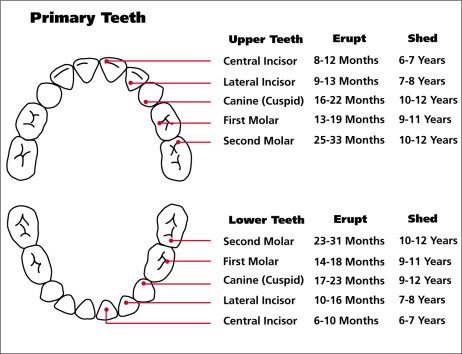Teething is a significant milestone in a baby’s early development. For many parents, especially first-time moms, it can be both an exciting and challenging time.
Although it is a sign that your baby’s body is developing well and you’ll soon start another phase – such as introducing foods –, the teething step requires adaptation and patience.
In this article, you’ll learn when the teething begins, what happens during this stage, what are the common signs of teething, and how to navigate through eventual discomforts without compromising your baby’s health.
When Do Babies Start Teething?
Typically, babies begin teething between 4 to 7 months, though some may start earlier or later.
By the age of 3 years, most children will have all 20 primary teeth fully developed.
What to do When The First Teeth Appear?
The emergence of a baby’s first tooth is an exciting moment, but it also marks the beginning of their oral care journey.
Parents should start caring for their child’s dental health as soon as the first tooth erupts!
Your first task is to set an appointment with a dentist within 6 months of the first tooth emerging. They’ll provide the necessary information to guide you through this stage and teach your Little One how to take care of their dental health!
Common Signs of Teething
Every baby experiences teething differently, but there are common symptoms parents can look out for.
Some of the most frequent teething signs include:
- Excessive drooling
- Irritability and fussiness
- Swollen or sensitive gums
- Chewing on hands, toys, or objects
- Changes in sleep patterns
- Decreased appetite
These manifestations can come and go, and your baby might not feel them all. Also, they are likely to occur right before the teeth emerge.
Symptoms That Are Not Related to Teething
While teething can cause mild discomfort, some symptoms are not linked to teething and may indicate an underlying issue.
If your baby exhibits the following, consult a pediatrician:
- Fever over 100.4°F (or 38°C)
- Diarrhea
- Severe rashes
- Vomiting
Additionally, some babies may pull their ears or rub their cheeks while teething. This is usually normal, as teething pain can radiate along the jaw.
However, if a fever accompanies these actions, it may be a sign of an ear infection and should be evaluated by a doctor.
What Order Do Baby Teeth Appear?
As soon as you notice some of the symptoms of teething, we already know you’ll probably spend more checking your baby’s mouth!
Here’s what you can expect, according to a general timeline for how baby teeth emerge by the American Dental Association (ADA).
Bottom central incisors (lower front teeth): 6–10 months
Top central incisors (upper front teeth): 8–12 months
Top lateral incisors (teeth next to front teeth): 9–13 months
Bottom lateral incisors: 10–16 months
First molars: 13–19 months
Canines (cuspids): 16–22 months
Second molars: 23–33 months
While this is a typical order, every child is different, and their teeth may come in at slightly different times.

Soothing Teething Pain
Teething discomfort can make babies restless and fussy, but there are several ways parents can help ease the pain.
First and foremost, take care of your emotions: be patient and understand that this is just a phase that will pass! Even if your baby is experiencing a little irritation, it will soon be over.
Now, here are other strategies that you can implement during the teething stage.
Teething toys
These are specific toys for babies that gently massage your baby’s gums while still stimulating their sensory play. Choose BPA-free teething rings or silicone-based toys for safe chewing.
Chilled (not frozen) washcloths
A cool, damp washcloth can help soothe sore gums. Just be mindful of the cloth’s temperature because your baby’s gums are sensitive and could get harmed if it’s too cold.
Gentle gum massage
In addition to teething toys, many parents use their own fingers to massage the gums and relieve some of the discomfort – which is helpful when you find yourself in a situation away from home and see that your baby is struggling with teething.
Naturally, make sure your hands are clean before engaging with this strategy.
Cold foods
If your baby has started solids, offer chilled fruits like a cold banana in a mesh feeder. Just as with the cold cloth, make sure the temperature of the fruits is suitable for the baby’s delicate moth.
What to Avoid During Baby Teething
As always, there are a few strategies that are not recommended when trying to calm your baby’s discomfort during teething.
- Products containing benzocaine or lidocaine: these numbing agents are not recommended for infants due to potential serious side effects.
- Liquid-filled teething rings: these may leak or break, posing a choking hazard.
- Extreme cold objects: freezing teething rings can cause them to break, potentially harming your child’s gums.
- Amber teething necklaces: these are not FDA-approved and pose a strangulation or choking risk if beads break off.
When to Consult a Pediatrician
While teething is a natural process, some situations warrant medical attention.
Make sure to consult your pediatrician as soon as possible if you notice any of these scenarios:
- No teeth have erupted in 18 months.
- Your baby is experiencing high fever, persistent diarrhea, or vomiting.
- Swelling in the gums appears severe or signs of infection develop.
- Your child seems to be in extreme pain that isn’t relieved by common remedies previously recommended by your pediatrician.
Implementing Strategies to Manage the Teething Phase
Now you know when babies start teething! This is an essential part of your baby’s growth, but it can be a challenging time for parents. Just know that it will pass, and use this time to bond with your child, showing you’ll always be there to look out for them.
Also, understanding the process, recognizing symptoms, and knowing how to ease discomfort can help you navigate this milestone with confidence.
Last reminder: remember that every child develops at their own pace, and a little extra care and patience can make all the difference.
Taking care of your Little One also involves managing their bed time and providing them the best conditions for a good night’s sleep. Next, discover how sleep sounds can help your teething baby rest better.


